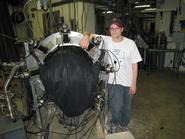
A physicist is different from a biologist or chemist in that his data will always be open to debate. No matter how hard he tries, he will not be able to flawlessly measure a physical value, whether it is momentum, magnetic field, or moment of inertia. According to him, uncertainty behaves asymptotically – the range of error gets closer and closer to zero but never reaches it. Scientists are especially fond of tacking more decimal places onto physical constants, like gravity. They make it their goal to alleviate uncertainty as much as possible.
Glenn Smith ’10 is one of those scientists. He is working with Professor of Physics Gordon Jones on the aCORN Magnet Design project, based at the National Institute of Standards and Technology (NIST). NIST was founded in 1901 and promotes precise measurement in science and technology. Higher degrees of accuracy allow the U.S. to maintain industrial competitiveness and improve quality of life. Jones and his colleagues are trying to find a more exact measure of the physical constant a, or the electron-antineutrino correlation coefficient. It is used in describing beta-decay, but its value is somewhat vague.
Neutron beta decay is a type of radioactive decay in which a beta particle (electron) and an antineutrino are emitted from an atomic nucleus, and a neutron is converted into a proton. NIST has the value of the correlation between the electron and antineutrino to within five percent, but that’s not good enough, says Smith. Although he knows this project will take much longer than a few summer months, he is eager to do all he can to help.
His responsibilities include calibrating 27 detectors on the magnetic apparatus aCORN uses. It is able to generate an extremely uniform field. Smith will help correct any defects it has and make sure it is working properly. He says looking beyond the numbers is important.
“I would like to improve my ability to analyze data,” he said. “There are so many different ways to look at things, and how you look at them makes a difference in the experiment.”
Smith worked on the same project last year, and he thinks the real-world applications will put him ahead of the crowd when he goes to graduate school for nuclear physics. He is learning to read a set of numbers and analyze it, much like a bibliophile would try to understand what goes on beneath the pages of a novel.
“You don’t want just one value, you want to see everything along the way – so you ask ‘How does this energy correspond to where it hit?’ as opposed to just ‘What was the energy?’ These are the type of questions we ask.’”
Glenn Smith ’10 is one of those scientists. He is working with Professor of Physics Gordon Jones on the aCORN Magnet Design project, based at the National Institute of Standards and Technology (NIST). NIST was founded in 1901 and promotes precise measurement in science and technology. Higher degrees of accuracy allow the U.S. to maintain industrial competitiveness and improve quality of life. Jones and his colleagues are trying to find a more exact measure of the physical constant a, or the electron-antineutrino correlation coefficient. It is used in describing beta-decay, but its value is somewhat vague.
Neutron beta decay is a type of radioactive decay in which a beta particle (electron) and an antineutrino are emitted from an atomic nucleus, and a neutron is converted into a proton. NIST has the value of the correlation between the electron and antineutrino to within five percent, but that’s not good enough, says Smith. Although he knows this project will take much longer than a few summer months, he is eager to do all he can to help.
His responsibilities include calibrating 27 detectors on the magnetic apparatus aCORN uses. It is able to generate an extremely uniform field. Smith will help correct any defects it has and make sure it is working properly. He says looking beyond the numbers is important.
“I would like to improve my ability to analyze data,” he said. “There are so many different ways to look at things, and how you look at them makes a difference in the experiment.”
Smith worked on the same project last year, and he thinks the real-world applications will put him ahead of the crowd when he goes to graduate school for nuclear physics. He is learning to read a set of numbers and analyze it, much like a bibliophile would try to understand what goes on beneath the pages of a novel.
“You don’t want just one value, you want to see everything along the way – so you ask ‘How does this energy correspond to where it hit?’ as opposed to just ‘What was the energy?’ These are the type of questions we ask.’”
Posted August 5, 2009
